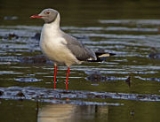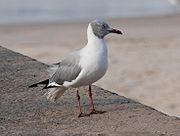
Grey-headed Gull
Encyclopedia
The Grey-headed Gull is a small gull
which breeds patchily in South America
and Africa
south of the Sahara
. It is not truly migratory
, but is more widespread in winter. This species has occurred as a rare vagrant to North America
and Spain
. It is also known as the Grey-hooded Gull. As is the case with many gulls, it has traditionally been placed in the genus
Larus
.
This locally abundant gull breeds in large colonies in reedbeds and marshes, and lays two or three eggs in a nest that can be on the ground or floating. Like most gulls, it is highly gregarious in winter, both when feeding or in evening roosts. Although it is predominantly coastal or estuarine, it is not a pelagic species, and is rarely seen at sea far from land.
Flocks numbering hundreds or thousands of these gulls can form when the feeding conditions are appropriate.
 The Grey-headed Gull is slightly larger than the Black-headed Gull
The Grey-headed Gull is slightly larger than the Black-headed Gull
at 42 cm length. The summer adult has a pale grey head, a grey body, darker in tone than the Black-headed, and red bill and legs. The black tips to the primary wing feathers have conspicuous white "mirrors". The underwing is dark grey with black wingtips. The grey hood is lost in winter, leaving just dark streaks.
Sexes are similar. The South American race is slightly larger and paler-backed than the African subspecies
. This gull takes two years to reach maturity. First year birds have a black terminal tail band, and more dark areas in the wings.
In flight, the wings are broader and held flatter than those of Black-headed Gull.
This is a noisy species, especially at colonies. The call is a raucous crow
-like caw, caw.
The rare species was just recently found at Coney Island
on August 1st, 2011. Scientist say this is extremely rare as it only breed in parts of Africa
.
Gull
Gulls are birds in the family Laridae. They are most closely related to the terns and only distantly related to auks, skimmers, and more distantly to the waders...
which breeds patchily in South America
South America
South America is a continent situated in the Western Hemisphere, mostly in the Southern Hemisphere, with a relatively small portion in the Northern Hemisphere. The continent is also considered a subcontinent of the Americas. It is bordered on the west by the Pacific Ocean and on the north and east...
and Africa
Africa
Africa is the world's second largest and second most populous continent, after Asia. At about 30.2 million km² including adjacent islands, it covers 6% of the Earth's total surface area and 20.4% of the total land area...
south of the Sahara
Sahara
The Sahara is the world's second largest desert, after Antarctica. At over , it covers most of Northern Africa, making it almost as large as Europe or the United States. The Sahara stretches from the Red Sea, including parts of the Mediterranean coasts, to the outskirts of the Atlantic Ocean...
. It is not truly migratory
Bird migration
Bird migration is the regular seasonal journey undertaken by many species of birds. Bird movements include those made in response to changes in food availability, habitat or weather. Sometimes, journeys are not termed "true migration" because they are irregular or in only one direction...
, but is more widespread in winter. This species has occurred as a rare vagrant to North America
North America
North America is a continent wholly within the Northern Hemisphere and almost wholly within the Western Hemisphere. It is also considered a northern subcontinent of the Americas...
and Spain
Spain
Spain , officially the Kingdom of Spain languages]] under the European Charter for Regional or Minority Languages. In each of these, Spain's official name is as follows:;;;;;;), is a country and member state of the European Union located in southwestern Europe on the Iberian Peninsula...
. It is also known as the Grey-hooded Gull. As is the case with many gulls, it has traditionally been placed in the genus
Genus
In biology, a genus is a low-level taxonomic rank used in the biological classification of living and fossil organisms, which is an example of definition by genus and differentia...
Larus
Larus
Larus is a large genus of gulls with worldwide distribution . Many of its species are abundant and well-known birds in their ranges...
.
This locally abundant gull breeds in large colonies in reedbeds and marshes, and lays two or three eggs in a nest that can be on the ground or floating. Like most gulls, it is highly gregarious in winter, both when feeding or in evening roosts. Although it is predominantly coastal or estuarine, it is not a pelagic species, and is rarely seen at sea far from land.
Flocks numbering hundreds or thousands of these gulls can form when the feeding conditions are appropriate.

Black-headed Gull
The Black-headed Gull is a small gull which breeds in much of Europe and Asia, and also in coastal eastern Canada. Most of the population is migratory, wintering further south, but some birds in the milder westernmost areas of Europe are resident...
at 42 cm length. The summer adult has a pale grey head, a grey body, darker in tone than the Black-headed, and red bill and legs. The black tips to the primary wing feathers have conspicuous white "mirrors". The underwing is dark grey with black wingtips. The grey hood is lost in winter, leaving just dark streaks.
Sexes are similar. The South American race is slightly larger and paler-backed than the African subspecies
Subspecies
Subspecies in biological classification, is either a taxonomic rank subordinate to species, ora taxonomic unit in that rank . A subspecies cannot be recognized in isolation: a species will either be recognized as having no subspecies at all or two or more, never just one...
. This gull takes two years to reach maturity. First year birds have a black terminal tail band, and more dark areas in the wings.
In flight, the wings are broader and held flatter than those of Black-headed Gull.
This is a noisy species, especially at colonies. The call is a raucous crow
Crow
Crows form the genus Corvus in the family Corvidae. Ranging in size from the relatively small pigeon-size jackdaws to the Common Raven of the Holarctic region and Thick-billed Raven of the highlands of Ethiopia, the 40 or so members of this genus occur on all temperate continents and several...
-like caw, caw.
The rare species was just recently found at Coney Island
Coney Island
Coney Island is a peninsula and beach on the Atlantic Ocean in southern Brooklyn, New York, United States. The site was formerly an outer barrier island, but became partially connected to the mainland by landfill....
on August 1st, 2011. Scientist say this is extremely rare as it only breed in parts of Africa
Africa
Africa is the world's second largest and second most populous continent, after Asia. At about 30.2 million km² including adjacent islands, it covers 6% of the Earth's total surface area and 20.4% of the total land area...
.

